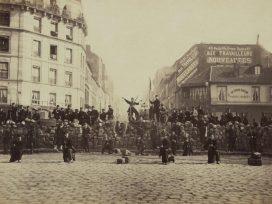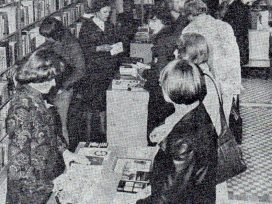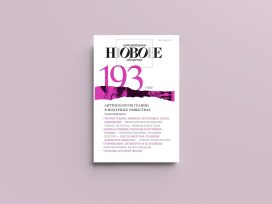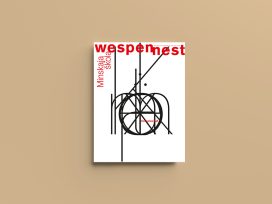Flemish literature has entered the twenty-first century and the world shall know it. As a matter of fact, its renaissance seems to have coincided with the moment Fukuyama’s notion of the “end of history” (and hence a particularly neoliberal type of postmodernity) collapsed: 9/11. If a metaphorical approach to this moment of literal horror is permissible, then the world found itself once again caught up in struggle over the course of history. For reasons I would like to explain, this re-historicizing and re-politicizing turn at the globalized, post-national level corresponded closely with Flemish literature’s gradual development towards becoming more self-consciously Flemish. At the same time, recent Flemish prose clearly shows that by opening up to worldly reality it has received new impetus. Let me tell you.
Towards autonomy
Flanders has a tradition of vernacular prose-writing going back to the Middle Ages. The habit of classing literature from Flanders as “Flemish” is, however, only very recent and still controversial. Throughout the nineteenth and twentieth centuries, the category “Flemish” was largely considered provincial; to use it was to obstruct the cultural emancipation Flanders needed. As the Dutch-speaking majority in (socio-)historically French-dominated Belgium, Flanders thought it strategically wiser to stress its linguistic nexus with the Netherlands, a logic underpinned by its close historical ties and the high level of interaction between the Low Countries. Flanders thus hoped to benefit, both nationally and internationally, from the wider context the idea of a unified Dutch literature could offer.
Paradoxically, however, this stress on the union of Dutch literatures fostered an inferiority complex in Flanders that was quite contrary to the emancipatory ideal of the advocates of integration. Put differently, the fear that a navel-gazing nationalism would hinder Flanders’ need for emancipation from Belgium, and the subsequent investment, both symbolically and institutionally, in linguistic and cultural union with the Netherlands, actually condemned Flanders to the position it tried to flee from. Given their evident kinship, this position was that of a poor little sister, culturally and economically less developed than its sibling. Thus, nearly all prominent, post-war Flemish writers, including the internationally acclaimed Louis aul Boon and Hugo Claus, ended up being published (and receiving more praise) in the Netherlands. Extra Amsterdam nulla salus, the creed of literary Flanders sounded.
Nowadays, despite attempts to rectify it, this structural imbalance is still partly in place – especially since the professional book market in the Netherlands remains better organized. However it is also clear that something has changed at the beginning of the twenty-first century, a change that can be synthesized in a simple image: the little sister has matured. In fact, “Flemish literature” has ceased to be a literature that dares not speak its name. Flanders’ obtainment of political autonomy as a federal (Belgian) region and community allowed it to create a Flemish Literature Fund in 1999 that functions both as a “payer” and a “player”, supporting and organizing the literary field. At the same time, the Netherlands also ceased to be perceived in Flanders as a guide, and the Flemish public sphere became more auto-directed and internationalized.
Beyond postmodernism
To some, this evolution went hand in hand with a conceited closing of the mind. And indeed, the populist, commerce-driven obsession in many media with all things Flemish, especially vis-à-vis literary prizes, gives that impression. On the level of literary practice itself, however, the exact opposite is true. The end of the Nineties and the beginning of the Noughties saw the flowering of a large number of writers no longer burdened by the complexity – both real and imaginary – that traditionally clings to Flemish identity and literary language. They now act out this complexity in an uncomplicated, open-minded and highly varied manner. What these writers have in common is precisely that they have nothing in common, except perhaps their “Flemishness”, the latter understood not as a territorial given or even as a nationality (for it is not: they are all Belgian), but as a historical and political condition that has generated a common sensitivity toward language and identity.
It is precisely this sensitivity, grounded in a historical consciousness about the life of the polis, that makes Flemish literature particularly suited to going beyond postmodernism. It explains its sense of urgency, the result of a combination of stylistic individualism and social (though hardly ever strictly realist) commitment, which made one Dutch critic exclaim in 2006 that “the Belgians are better” than their counterparts in the Netherlands. Despite the exoticism and absurd competitiveness of this comment, it pinpointed an overall dynamism that has led to a number of remarkable (and often prize-winning) successes of Flemish novels in Flanders, the Netherlands and abroad: Annelies Verbeke’s Slaap! (“Sleep!”, 2003), Stefan Brijs’ De Engelenmaker (“The angel maker”, 2005), Dimitri Verhulst’s De helaasheid der dingen (“The terribleness of things”, 2006), Erwin Mortier’s Godenslaap (“Divine sleep”, 2008), Bernard Dewulf’s Kleine dagen (“Small days”, 2009) or, most recently, David Van Reybrouck’s non-fictional Congo: Een geschiedenis (“Congo: A history”, 2010). As all these books are very different, however, the question remains as to what this dynamism (beyond “pomo”) entails.
Of course, like all (post-)modern literatures, contemporary Flemish literature defeats all attempts to describe it in terms of a grand narrative. Poetical, programmatical or generational grouping no longer occurs, since the dialectic of tradition and innovation that once underpinned it no longer holds sway. We still talk about the generation of Tom Lanoye, Herman Brusselmans or Kristien Hemmerechts, no doubt, as figureheads representing the literary outburst of the Eighties. Just as we recently celebrated the tenth anniversary of the generation that made its debut in 1999: Erwin Mortier, Dimitri Verhulst, Yves Petry, Christophe Vekeman – to name those still known. Yet, as the massive differences in their work shows, the grouping of these writers is more a promotional or media-driven construction surfing on a nostalgia for the miraculously “new” than the product of literary affinities. In fact, only a strictly individual approach seems able to account for the dynamism that today’s Flemish writers commonly engender.
The return of the real(istic)
This sounds like a paradox. On the one hand, their individual differences prevent today’s writers from grouping or being grouped together, at least in a meaningful way. On the other hand, their individualism is precisely what links them. Yet far from being a sign of weakness, this individualism is at the core of their literary commitment: as a reaction to the reduction of subjectivity, both personally and politically, in times of consumerism or market-driven depersonalization. This issue is explicitly tackled in the stylistically and intellectually brilliant work of Yves Petry, for example De achterblijver (“The laggard”, 2006) or De Maagd Marino (“Marino the virgin”, 2010), which examine the moral and bodily limits of the human. It is also at stake, albeit in a different way, in the novels of Jeroen Theunissen (Een vorm van vermoeidheid / “A form of fatigue”, 2008), David Nolens (Stilte en melk voor iedereen / “Silence and milk for everyone”, 2008) and Annelies Verbeke (Vissen redden / “Saving fish”, 2009). Their protagonists move to a vanishing point, struggling to rescue or recreate a sense of self while gradually realizing how they have been emptied out by the discourses that encroach upon them, the language games they have been played by. Through fiction, these novels both observe and look for ways to cope with the very fictional constructions in which our sense of subjectivity and reality is nowadays caught up.
This discursive realism, centring on the tension between the impersonal working of discourse and the fictional subject’s (lack of) authenticity, is closely connected with the major tendency in literature’s move beyond postmodernism: “the return of the real”. In today’s Flemish fiction, this is sometimes thought to be marked by a renewed interest in traditional realism: away from postmodernism’s metafictional narcissism and back to craftsmanship and straightforward storytelling with a worldly, if not earthly message.
This general development can indeed be clearly discerned, albeit as the sum of several separate evolutions. Postmodern writers have turned away from earlier, self-reflective fictional constructions in order to address the world more directly (e.g. Stefan Hertmans, Harder dan sneeuw / “Harsher than snow”, 2004), making use of traditional genres (e.g. the regional novel, in Koen Peeters’ De bloemen / “The flowers”, 2009). At the same time, a revival of intimistic, ruminative and melancholic prose occurred (e.g. Gie Bogaert). Sensuous mastery of language, exuberant or restrained, enables the remembrance of things past, revealing a stealthily suppressed history, often with an autobiographical slant (Mortier, Marcel / “Marcel”, 1999, Joseph Pearce, Vaderland / “Fatherland”, 2008, or Leo Pleysier, Dieperik / “Into the deep”, 2010). As such, this revival of memory-writing ties in with a major practice in Flemish prose from the early Eighties onwards to localize and familiarize history (e.g. Hugo Claus, Het verdriet van België / The Sorrow of Belgium, 1983). As shown by the work of Monika van Paemel and Walter van den Broeck, both still going strong, this writing comes mostly with a socio-cultural critique, largely influenced by naturalism. Carried on, so to speak, in the work of Erik Vlaminck (e.g. Suikerspin / “Candy floss”, 2008) or, more recently, Bart Vercauteren (Het graf van de voddenraper / “The ragpicker’s grave”, 2010), it is also about telling a good story, true to life yet slightly legendary (or fantastical). Finally, as exemplified by the novels of the modern Heimat-writer Van den Broeck, whose regional novel Terug naar Walden (“Back to Walden”, 2009) tackles the global financial crisis, there is a (reality-checked) continuum between the socio-critical tradition and the emancipatory storytelling that developed through the arrival of Flemish writers with a different, cultural origin. The writing of Rachida Lamrabet (Morrocan), Chika Unigwe (Nigerian) and others are to a large extent concerned with the disillusions and hopes of multicultural society, mainly though not exclusively told from the point of view of (subsequent generations of) immigrants themselves (e.g. Lamrabet’s Vrouwland / “Womenland”, 2007, or Unigwe’s On Black Sister’s Street, 2007, both telling the story of African prostitutes in Antwerp). As such, they signal a return of the real, if not its arrival, since the experiences they fictionalize have never found their way in Flemish literature before.
The return of the real, again
The return of the real should not be reduced to the revival of skilful realism, however, especially since the writing sometimes contains artful and even romantic elements (such as stylistic embellishment and dreamlike, poetic suggestiveness) that are quite at odds with the uncanny viscerality “the return of the real” usually entails. In fact, when it comes to Flemish literature’s move “beyond postmodernism”, two other developments are more decisive. The first is what I would like to call the appearance of a virtual realism. The dichotomous play between fiction and reality, as we conventionally know it, is doubled and turned inside out by the way the virtual encroaches on our sense of reality (via technological mediations such as the Internet). For its viral terror, Peter Verhelst’s Zwerm (“Swarm”, 2005) is a good example, though still a very postmodern one – it actually shows postmodernism pushed to its extreme.
Paul Mennes’ Kamermuziek (“Chamber music”, 2007), about a young man losing track of reality by living according the virtual in his head, represented a deliberate shift by embedding the character’s experience in everyday reality. Likewise, Jan van Loy’s De heining (“The fence”, 2008) frames its account of a couple whose sense of security is shaken after moving to a gated community with the theme of camera surveillance, which is presented as an illusory doubling of reality that blurs the distinction between inside and out. However the best example till now of the fusion of fiction and reality is De bewaker (“The guard”, 2009) by Peter Terrin, a literary maverick and masterful stylist. Set largely in the underground car park of a luxury block of flats, two security guards who have come to believe that the outside world has been struck by a terrible disaster, experience their perception of reality truly exploding. A psychological novel and a love story, it is foremost a Beckettian allegory of twenty-first century society. Like in Elvis Peeters’ near documentary report of the moral nihilism and extreme hedonism of the twenty-first century’s virtually apathetic youth in Us (“Us”, 2009), the return of the real is presented as an intrusion of violence. And so it is in all the stories of Joost Vandecasteele (Hoe de wereld perfect functioneert zonder mij / “How the world works perfectly well without me”, 2009; Opnieuw en opnieuw en opnieuw / “Again and again and again”, 2010), where elements of reality TV, cult, comic and myth are blended in the fantasy of a manic, hyperbolic, post-apocalyptic world, more real than reality as we know it.
This fusion of reality and fiction, mirroring our increasingly virtual experience of the world and exploring its relation to violence, is not always in evidence, however. As the documentary semblance of Us hints, the return of the real goes also hand in hand with a heightened interest in non-fictional strategies. Both autobiography and documentary are used (and mingled) for maximum literary effect to communicate the writer’s object of interest or, most often, fascination. The best example is doubtlessly the literary non-fiction of David Van Reybrouck. His debut De plaag (“The plague”, 2001), which starts off by exploring a suspected case of plagiarism in the work of Maurice Maeterlinck but ends up in an investigative and confrontational journey to South-Africa in the tracks of Eugène Marais, triggered this renewed interest in the relation between literature and non-fiction. The latter is linked to the debate on commitment in writing – a reaction to literature’s new position in society itself – that has been at the forefront of literary discussions in recent years. Yet it is also connected with a renewed interest in the relation between art and truth in general, and in particular the question of how to position subjectivity vis-à-vis reality, or represent it truthfully.
This question has been instructive for the way the limits of the documentary genre have been tested and stretched as a whole, implying among others fictional strategies. Yet, it has also fostered the use of non-fictional content as a catalyst for the renewal of conventional fictional writing. Following the journalistic approach of Reybrouck’s predecessors in literary non-fiction, the equally highly-acclaimed Lieve Joris and Chris De Stoop, some novelists have taken recourse to documentary: Dimitri Verhulst in Problemski Hotel (“Problemski hotel”, 2003), a story about imprisoned, “illegal” immigrants, and Tom Naegels in Los (“Loss”, 2005), a novel about a newspaper journalist whose leftist belief in multicultural society is tested after reporting on “immigrant riots” in Antwerp. In the case of Verhulst, this non-fictional interlude boosted his career as one of Flanders’ most prominent fiction-writers, endowing him with the credentials of a reality-based storyteller (which he is not all the time).
The end is speechlessness
This documentary slant is something most Flemish writers have in common today, at least when it boils down to language. No longer burdened by the need to adapt to a linguistic standard that is not theirs, many Flemish writers have developed a rich, stylistic play with existing or semi-existing linguistic registers, including the Dutch of the Netherlands (as a variant among many). This linguistic polyphony increases the fiction’s impression of reality, even for readers in the Netherlands. It directly mirrors, so to speak, the historical, political and socio-cultural context that has sedimented in the Flemish attitude towards language, uneasy yet playful. Yet it is not only used to suggest plain realism. On the contrary, in a novel such as Jeroen Olyslaegers’ Wij (“We”, 2009), linguistic mimesis (of the way Flemish people speak, cannot speak, want to speak) is often embedded in a subtle, fictive montage that aims for a satirical, if not grotesque, effect: a relativization of all claims on the real, that is. As such, this play with language continues the typical mix of experimental writing with popular, common ways of speaking that is so central to Flanders’ biggest, most innovative writers of the second half of the twentieth century: Louis Paul Boon (e.g. the magnificent De kapellekensbaan / Chapel Road, 1953) and Hugo Claus. In fact, one of their most prominent, literary bastard sons, Tom Lanoye, recently pushed his capacity in experimenting with language to the limit in an autobiographical novel about the loss of language and dementia, preceding the death of his mother (a common woman who incorporates the Flemish “mother tongue”). Sprakeloos (Speechless, 2010) synthesizes what Flemish literature at the beginning of the twenty-first century has to offer: it is both true to life and theatrical, bare yet baroque, eloquent and at a loss for words, powerless yet powerful. If it did not exist, one would have to invent it.






